Covid hotspots: Why Switzerland’s situation is ‘extremely unfavourable’

As the year is drawing to a close, Switzerland is registering the highest-ever number of Covid cases. This is where the hotspots are right now.
On Wednesday, the Federal Office of Public Health (FOPH) recorded 17,634 new cases of coronavirus, the highest-ever number of daily infections. It is a significant jump from the already high 11,167 contaminations reported seven days ago.
Among its neighbours, Switzerland’s rate of infections is second-highest, below France but well above Germany, Italy and Austria.
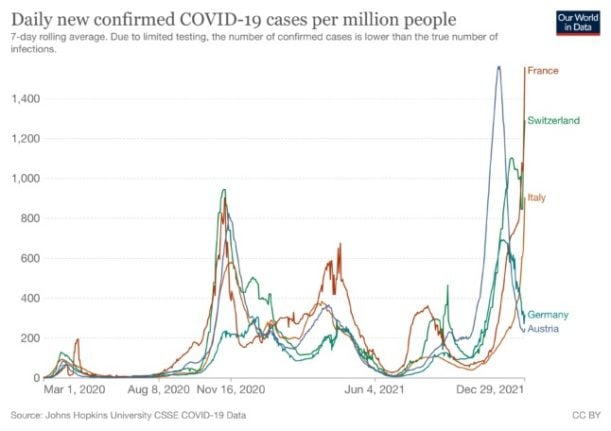
To say the least, this epidemiological evolution “is extremely unfavourable”, according to Patrick Mathys, head of FOPH’s crisis management section.
One major reason for such an exponential increase is the rapid spread of the Omicron variant, which experts believe is more transmissible and contagious than existing variants.
Omicron is now the main mutation in Switzerland, accounting for 57.8 percent of all Covid cases and supplanting the previously dominant Delta.
READ MORE: Switzerland records new daily record for Covid cases
This is what the epidemiological situation looks like now:
With 1,531.4 cases per 100,000 population — up from 1,414.2 a week ago — the overall incidence over the past 14 days is on the rise again.
The highest rates, which far exceed the national average, are in Obwalden (2,456.1), Geneva (2,360.2), Ticino (2,098.9), Jura (2,066.2), Valais (1,952.3) ) and Vaud (1,903,2).
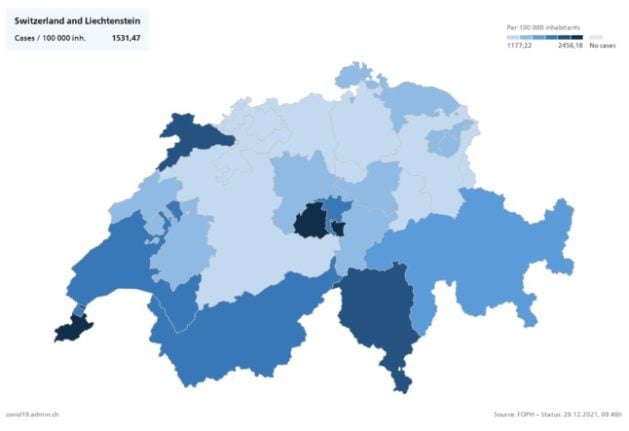
As the map below shows, as recently as a month ago, the French-speaking cantons and Ticino were mostly unaffected by the rising contamination rates, with most pockets of infection concentrated in eastern and central Switzerland. In recent weeks, however, the wave of infections has spread westward.
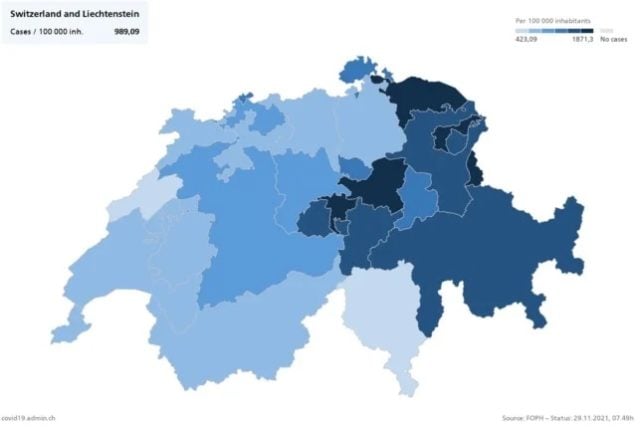
And Omicron is expected to wreak even more damage: “a number of cases exceeding 20,000 per day by the second week of January is a plausible scenario”, according to the latest analysis of the country’s epidemiological evolution by the Covid-19 Task Force.
READ MORE: ‘20,000 cases per day’: Experts draw Covid forecast for Switzerland
In terms of hospitalisations, the central cantons of Obwalden, Nidwalden and Schwyz, as well as Geneva, have the highest rate of hospital admissions per capita.
As far as intensive care units are concerned, 315 beds are occupied by Covid patients, who constitute 36.5 percent of all ICU patients in Switzerland.
By canton, the highest occupancy of ICU beds by coronavirus cases is in Solothurn (87.5 percent), Schaffhausen (66.7), and Neuchâtel (60 percent).
However, this data is at least several days old, and a number of hospitals are sounding the alarm about the worsening situation.
The Geneva University Hospitals (HUG), Switzerland’s largest medical facility, expects to be “under very strong tension” until the end of February, according to its director, Bertrand Levrat.
Hospitals in Zurich, Solothurn, Lucerne and Fribourg have also warned of overcrowding in ICUs, with each seeing a higher than 90 percent occupation rate on December 28th.
The majority of Covid patients are unvaccinated, as this FOPH chart indicates.
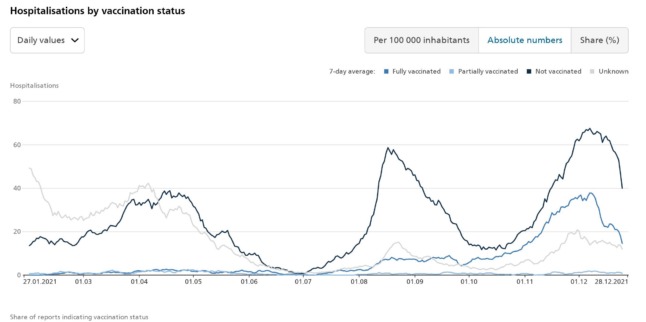
What about the death rate?
Unlike the number of infections and hospitalisations, Covid-related deaths have not been increasing.
This FOPH chart demonstrates how the number of coronavirus deaths per 100,000 people has declined between December 15th and 28th.
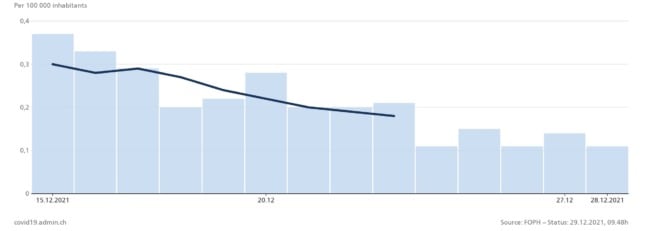
The fact that fewer people are dying of Covid is due to vaccination, according to Julien Riou, epidemiologist at the University of Bern.
“Vaccines are very effective at preventing 90 to 95 percent of severe cases and deaths. So the people who are most at risk now are the vulnerable and the non-vaccinated”, he said.
What measures will the Federal Council take as the infections continue to soar?
It is not certain at this point.
Current measures, such as the Covid certificate, as well as 2G and 2G-Plus rules, are supposed to stay in place until at least January 24th but could, depending on the epidemiological situation, be extended.
In the meantime, while Health Minister Alain Berset said on Wednesday that “the time has not yet come for the Federal Council to take new measures to fight the pandemic”, he did specify that “the next package of measures, which includes closures, is ready”.
“The Federal Council can react very quickly, as soon as precise data on the virulence of the Omicron variant becomes available”, Berset added.
Comments
See Also
On Wednesday, the Federal Office of Public Health (FOPH) recorded 17,634 new cases of coronavirus, the highest-ever number of daily infections. It is a significant jump from the already high 11,167 contaminations reported seven days ago.
Among its neighbours, Switzerland’s rate of infections is second-highest, below France but well above Germany, Italy and Austria.

To say the least, this epidemiological evolution “is extremely unfavourable”, according to Patrick Mathys, head of FOPH’s crisis management section.
One major reason for such an exponential increase is the rapid spread of the Omicron variant, which experts believe is more transmissible and contagious than existing variants.
Omicron is now the main mutation in Switzerland, accounting for 57.8 percent of all Covid cases and supplanting the previously dominant Delta.
READ MORE: Switzerland records new daily record for Covid cases
This is what the epidemiological situation looks like now:
With 1,531.4 cases per 100,000 population — up from 1,414.2 a week ago — the overall incidence over the past 14 days is on the rise again.
The highest rates, which far exceed the national average, are in Obwalden (2,456.1), Geneva (2,360.2), Ticino (2,098.9), Jura (2,066.2), Valais (1,952.3) ) and Vaud (1,903,2).

As the map below shows, as recently as a month ago, the French-speaking cantons and Ticino were mostly unaffected by the rising contamination rates, with most pockets of infection concentrated in eastern and central Switzerland. In recent weeks, however, the wave of infections has spread westward.

And Omicron is expected to wreak even more damage: “a number of cases exceeding 20,000 per day by the second week of January is a plausible scenario”, according to the latest analysis of the country’s epidemiological evolution by the Covid-19 Task Force.
READ MORE: ‘20,000 cases per day’: Experts draw Covid forecast for Switzerland
In terms of hospitalisations, the central cantons of Obwalden, Nidwalden and Schwyz, as well as Geneva, have the highest rate of hospital admissions per capita.
As far as intensive care units are concerned, 315 beds are occupied by Covid patients, who constitute 36.5 percent of all ICU patients in Switzerland.
By canton, the highest occupancy of ICU beds by coronavirus cases is in Solothurn (87.5 percent), Schaffhausen (66.7), and Neuchâtel (60 percent).
However, this data is at least several days old, and a number of hospitals are sounding the alarm about the worsening situation.
The Geneva University Hospitals (HUG), Switzerland’s largest medical facility, expects to be “under very strong tension” until the end of February, according to its director, Bertrand Levrat.
Hospitals in Zurich, Solothurn, Lucerne and Fribourg have also warned of overcrowding in ICUs, with each seeing a higher than 90 percent occupation rate on December 28th.
The majority of Covid patients are unvaccinated, as this FOPH chart indicates.

What about the death rate?
Unlike the number of infections and hospitalisations, Covid-related deaths have not been increasing.
This FOPH chart demonstrates how the number of coronavirus deaths per 100,000 people has declined between December 15th and 28th.

The fact that fewer people are dying of Covid is due to vaccination, according to Julien Riou, epidemiologist at the University of Bern.
“Vaccines are very effective at preventing 90 to 95 percent of severe cases and deaths. So the people who are most at risk now are the vulnerable and the non-vaccinated”, he said.
What measures will the Federal Council take as the infections continue to soar?
It is not certain at this point.
Current measures, such as the Covid certificate, as well as 2G and 2G-Plus rules, are supposed to stay in place until at least January 24th but could, depending on the epidemiological situation, be extended.
In the meantime, while Health Minister Alain Berset said on Wednesday that “the time has not yet come for the Federal Council to take new measures to fight the pandemic”, he did specify that “the next package of measures, which includes closures, is ready”.
“The Federal Council can react very quickly, as soon as precise data on the virulence of the Omicron variant becomes available”, Berset added.
Join the conversation in our comments section below. Share your own views and experience and if you have a question or suggestion for our journalists then email us at [email protected].
Please keep comments civil, constructive and on topic – and make sure to read our terms of use before getting involved.
Please log in here to leave a comment.